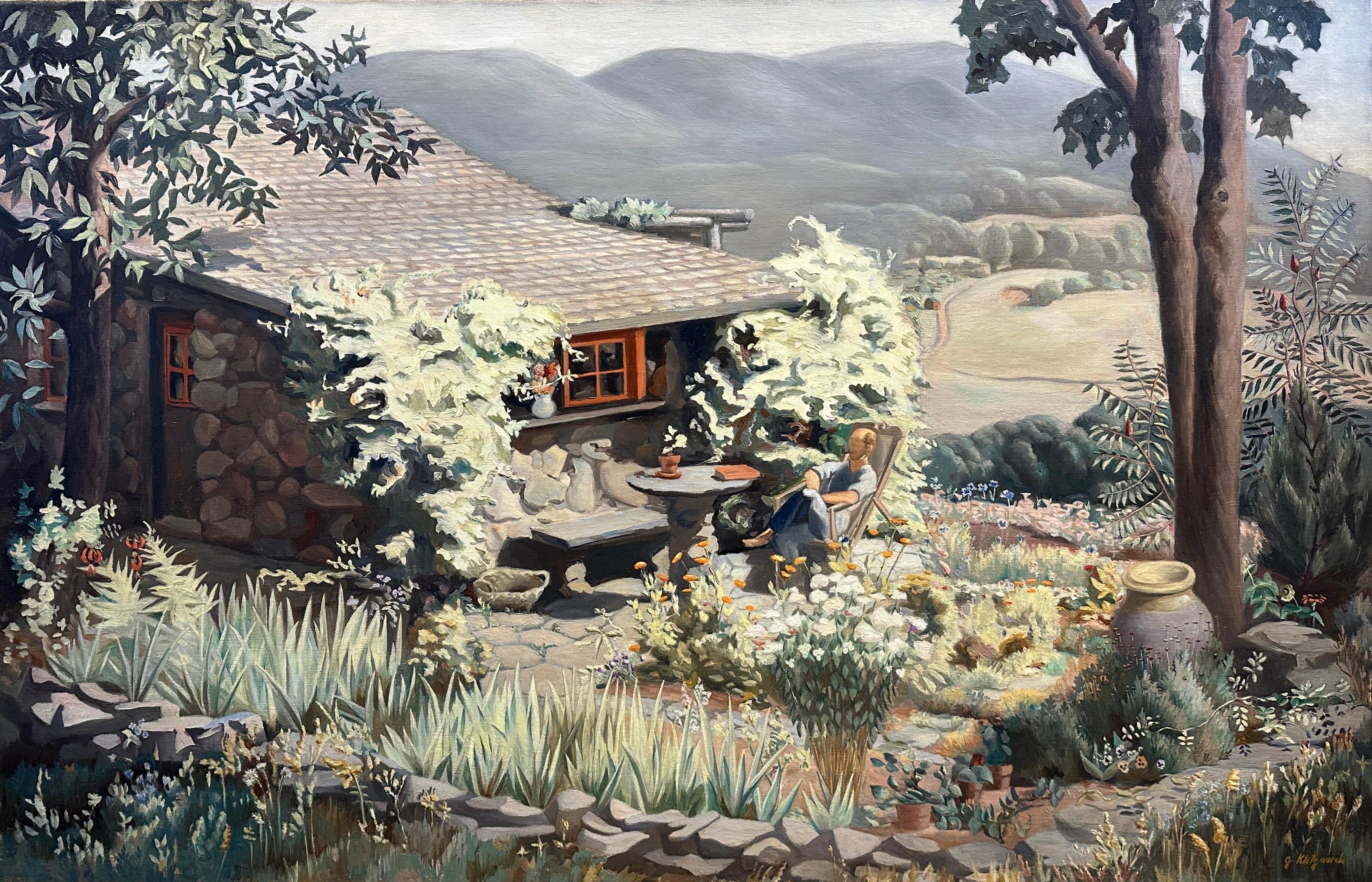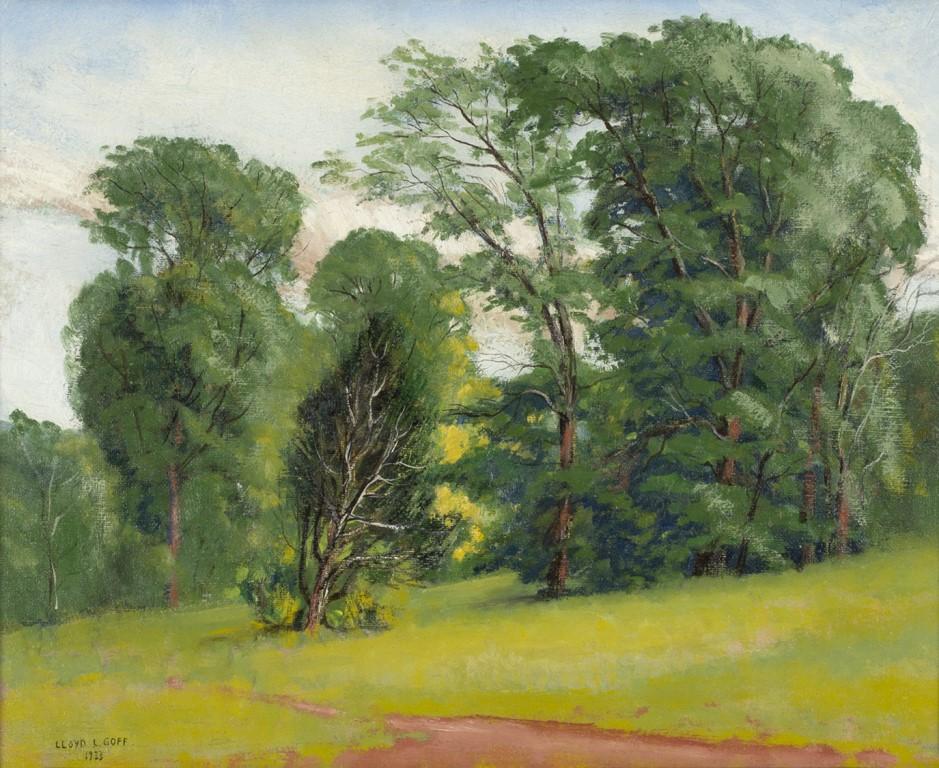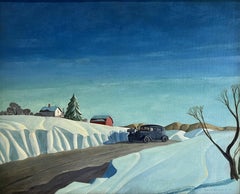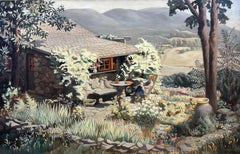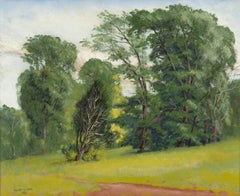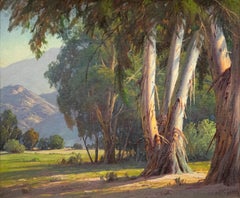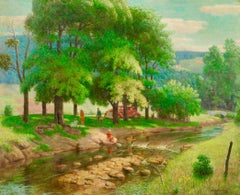Want more images or videos?
Request additional images or videos from the seller
1 of 4
Georgina KlitgaardThe Ledgeby 1931
by 1931
$20,000
£15,105.53
€17,457.52
CA$28,053.06
A$31,197.72
CHF 16,330.57
MX$380,574.24
NOK 205,199.52
SEK 193,016.64
DKK 130,309.08
About the Item
Georgina Klitgaard (1893 – 1976) The Ledge, by 1931, oil on canvas, signed lower right, 32 1/8 x 50 1/8 inches, exhibited: 1) 44th Annual Exhibition of American Paintings & Sculpture, Art Institute of Chicago, October 29 – December 13, 1931, no. 102; and 2) Retrospective Exhibition of Paintings by Georgina Klitgaard, Capricorn Gallery, Bethesda, MD, June 22 – July 21, 1974; literature: Jonas, Louise, Her Light Became a Symbol of Courage, Poughkeepsie Sunday Reporter, November 21, 1943 (illustrated)
The Ledge is an important and personal painting, depicting the artist’s husband, writer and sometimes artist, Kaj Klitgaard, sitting in front of their much beloved home in New York’s Catskill Mountains. In the early 1920s, the Klitgaards discovered a peaceful promontory on the sunny side of Mount Tobias above an expansive valley near the Woodstock artists colony. Without much consideration for the practicalities of living on an uninhabited hilltop, the Klitgaards built a shiplap shack with a fireplace. Soon after construction, Kaj went to sea to earn money, while Georgina stayed behind, alone in the small cottage without electricity or running water. Working alone, Georgina painted all day and into the night. When Kaj returned home the following year, Georgina recalled, “we seriously set about making a go of painting and writing.” As they pursued their respective crafts during the 1920s, the Klitgaards expanded the house and their family, as Georgina gave birth to the couple’s son, Peter. To the little cottage, the couple added more rooms and field stone cladding to the shiplap walls, resulting in the home featured in The Ledge. Eventually electricity and a pump to deliver running water up the hill were added so that by the end of the decade the home and studio became a cozy, if still isolated, refuge for the Klitgaards’ creativity. Georgina developed her innovative visual vocabulary from within the walls of the home that would become famous in the Woodstock area as “the Ledge.”
During the 1920s and 30s, Georgina Klitgaard, a native New Yorker, became one of the most accomplished female artists working in the United States. Her unique form of American Scene painting combined Regionalism with a naïve version of modernism. Klitgaard studied at Barnard College, the National Academy of Design, and the Art Students League. She had an early show in 1927 at the Whitney Club. By 1929, she was represented by New York’s important Rehn Galleries, which represented the artist into the 1960s. Klitgaard was a frequent exhibitor at the nation’s most significant museums, including the Whitney Museum of American Art, the Pennsylvania Academy of Fine Arts (PAFA), the Corcoran Gallery, the Virginia Museum of Fine Art, the Carnegie Institute, the Cincinnati Art Museum, the Los Angeles County Museum of Art, and the Art Institute of Chicago, where she exhibited The Ledge in 1931. She was also a frequent prize winner, taking home honors from PAFA, the Carnegie, and the San Francisco Art Association, among others. In 1933, she won a Guggenheim Fellowship. Later during the Great Depression, she was commissioned by the Treasury Department Section of Fine Arts to complete a mural for the post office in Poughkeepsie, New York. Her works are in the permanent collections of the Whitney, the Metropolitan Museum of Art, the Smithsonian American Art Museum, the New Britain Museum of American Art, the Dayton Art Institute, the Woodstock Art Association, and many other public and private collections. She is listed in Who was Who in American Art and other standard references.
- Creator:Georgina Klitgaard (1893-1976, American)
- Creation Year:by 1931
- Dimensions:Height: 32.125 in (81.6 cm)Width: 50.125 in (127.32 cm)
- Medium:
- Movement & Style:
- Period:
- Condition:
- Gallery Location:Los Angeles, CA
- Reference Number:1stDibs: LU1859216260952
Georgina Klitgaard
Georgina Berrian was born in Spuyten Duyvil, New York in 1893. She was educated at Barnard College and studied at the National Academy of Design in New York. She married the Danish-born mariner, artist, and writer Kaj Klitgaard in 1919. After visiting friends in Woodstock, the couple became committed to the area and built a home in 1922 in Bearsville which provided a panoramic view of the mountains and valleys of Woodstock. Georgina Klitgaard's first exhibition in New York was held at the Whitney Studio Club from Dec.20, 1927 to January 7, 1928. Klitgaard's New York dealer was the Frank Rehn Galleries, where she began to exhibit in the 1930s, continuing that relationship into the 1950s. In 1939 and again in 1940 she had solo exhibitions with the Milch Gallery in New York. By the late 1920s, Klitgaard began to show works at museum invitationals. She sent work to the Carnegie International in Pittsburgh, Pennsylvania each year from 1928 to 1949. The Corcoran Gallery of Art in Washington, DC invited Klitgaard to exhibit each year from 1930 to 1945. Klitgaard also exhibited works at the Virginia Museum of Fine Art in Richmond and the Pennsylvania Academy of the Fine Arts in Philadelphia from 1930 to 1945 annually. Klitgaard was also invited to exhibit regularly at the Whitney Museum of American Art from 1927 to 1944. In the 1936 works on paper component of the Whitney Biennial, Klitgaard exhibited Florida Landscape (No.116, a work on paper). In 1944 Klitgaard exhibited another Florida work, Early Spring, Florida (No. 7) at the Whitney. Based on this information, it seems likely that Klitgaard began to visit Florida in the winter during the 1930s and continued to do so until the 1940s. Many of her Woodstock artist friends, such as Doris Lee (1905-1983), found a way to spend time in Florida during the winter on a regular basis. Their experiences in Florida may have influenced Klitgaard to visit. In 1933 Georgina Klitgaard received a Guggenheim Fellowship which provided funds to travel in Europe. In 1940 the family traveled around the U.S. while Kaj, himself now the recipient of a Guggenheim, wrote Through the American Landscape. During the Depression she was selected to paint murals in post offices in Pelham, Georgia and Goshen (1937) and Poughkeepsie (1940) in Upstate New York. The Metropolitan Museum of Art acquired Girl and Child Under A Pine Tree, a colorful portrait, in 1939. By the 1940s Klitgaard's work was also in the permanent collections of the Whitney Museum of American Art; the Newark Museum; the New Britain Museum of American Art; and the Dayton Art Institute, as well as other public and private collections. Klitgaard was a member of the Audubon Artists and the American Society of Painters, Sculptors, and Gravers. She had a studio in New York City located at 659 Fifth Avenue. Klitgaard died in 1976. The bulk of her exhibited subjects were painted around the Woodstock or Bearsville area.
About the Seller
5.0
Vetted Professional Seller
Every seller passes strict standards for authenticity and reliability
1stDibs seller since 2022
15 sales on 1stDibs
Typical response time: <1 hour
- ShippingRetrieving quote...Shipping from: Los Angeles, CA
- Return Policy
Authenticity Guarantee
In the unlikely event there’s an issue with an item’s authenticity, contact us within 1 year for a full refund. DetailsMoney-Back Guarantee
If your item is not as described, is damaged in transit, or does not arrive, contact us within 7 days for a full refund. Details24-Hour Cancellation
You have a 24-hour grace period in which to reconsider your purchase, with no questions asked.Vetted Professional Sellers
Our world-class sellers must adhere to strict standards for service and quality, maintaining the integrity of our listings.Price-Match Guarantee
If you find that a seller listed the same item for a lower price elsewhere, we’ll match it.Trusted Global Delivery
Our best-in-class carrier network provides specialized shipping options worldwide, including custom delivery.More From This Seller
View AllJohnny Walker’s Place
By Georgina Klitgaard
Located in Los Angeles, CA
Johnny Walker’s Place, by 1929, oil on canvas, signed lower right, 34 x 42 inches, exhibited 1) 28th International Exhibition of Paintings, Carnegie Institute, Pittsburgh, PA, Octobe...
Category
1920s American Modern Landscape Paintings
Materials
Canvas, Oil
Landscape
Located in Los Angeles, CA
Landscape, c. 1930-40s, oil on panel, signed lower right, 16 x 20 inches
Jeanette Maxfield Lewis was a California-based landscape painter and etcher. Born in Oakland, she spent much...
Category
1930s American Modern Landscape Paintings
Materials
Oil, Panel
Untitled
Located in Los Angeles, CA
Untitled, c. 1940s, oil on Masonite, signed lower right, 19 ¾ x 25 ¾ inches
Ava Vorhaus Gabriel was a New York-based painter, lithographer, and designer. Born in Larchmont, Gabriel ...
Category
1940s American Modern Landscape Paintings
Materials
Masonite, Oil
RFD#1
By Dale Nichols
Located in Los Angeles, CA
RFD #1, 1937, oil on canvas, signed and dated lower right, titled verso, 24 x 30 inches
Iowa had Grant Wood. Missouri had Thomas Hart Benton. Kansas had John Steuart Curry. And, Neb...
Category
1930s American Modern Landscape Paintings
Materials
Canvas, Oil
$75,000
Atilt
Located in Los Angeles, CA
Atilt, 1982, acrylic on canvas, 32 x 48 inches, signed and dated lower right, “Alfred P. Maurice 2725 A South Michigan Ave, Chicago, IL, 60616” inscribed verso, “ATILT” inscribed ver...
Category
1980s American Modern Landscape Paintings
Materials
Canvas, Acrylic
Pleasant Ridge
Located in Los Angeles, CA
Pleasant Ridge, 1966-7, oil on board, signed, dated and titled verso, 16 x 24 inches, exhibited: Robert Herrmann, Cincinnati Art Galleries, Cincinnati, OH, March 4 to 28, 2000, no. 1...
Category
Mid-20th Century American Modern Landscape Paintings
Materials
Masonite, Oil
You May Also Like
"The Ledge" Georgina Klitgaard, Modernist Upstate New York Country Landscape
By Georgina Klitgaard
Located in New York, NY
Georgina Klitgaard
The Ledge, 1936-37
Signed lower right
Oil on canvas
30 x 52 inches
Georgina Klitgaard’s art has sometimes gotten lost in the critical propensity to assign artist...
Category
1930s American Modern Landscape Paintings
Materials
Canvas, Oil
Mid-Summer
Located in Dallas, TX
Lloyd Goff studied at the Art Students League, and has work in the collections of the Smithsonian American Art Museum, Whitney Museum of American Art, and T...
Category
1930s American Modern Landscape Paintings
Materials
Canvas, Oil
Rooted Silence
By Paul Grimm
Located in Palm Desert, CA
A painting by Paul Grimm. "Rooted Silence" is a landscape painting, oil on board in an earth-tone palette by artist Paul Grimm. It is signed in the lower right, "Paul Grimm".
Paul Grimm (1891-1974) was an artist born to German parents in South Africa in 1891. As a small child, he moved with his parents to the United States. He reportedly was seen as having artistic talent as a child and, as an adult, attended a university-level art school in New York. Between 1910 and 1920, he reportedly went to South America for a few years before returning stateside and settling in southern California.
Grimm gained much of his present-day fame by painting landscapes of southern California in the 1920s. Many works depict alluvial fans and desert vegetation in the eastern half of Riverside County. The San Jacinto Mountains appear frequently in his work. Most of the works are oil on canvas. A residence on Calle Palo Fierro in the Palm Springs Warm Sands Neighborhood was built for him in 1935. He had a studio on Palm Canyon Drive in Palm Springs from the 1950s until his death in 1974.
Provenance:
with George Stern Fine Arts...
Category
20th Century American Modern Landscape Paintings
Materials
Oil, Board
$25,000
"Escape"
By Norwood Hodge MacGilvary
Located in Fort Washington, PA
Medium: Oil on Board
Dimensions: 25.00" x 30.00"
Signature: Signed Lower Right
Exhibited Carnegie institute Pittsburgh
Category
Early 20th Century Landscape Paintings
Materials
Oil, Board
Country landscape in Summer
Located in Genève, GE
Work on canvas
Dimensions with frame : 63 x 71.5 x 4.5 cm
Country landscape in Summer
This captivating work depicts a peaceful landscape with a remarkable mastery of nuances of color...
Category
Mid-20th Century Landscape Paintings
Materials
Oil
From a Balcony
By Glenn O. Coleman
Located in Miami, FL
Exhibited: New York Society of Artist
Sid Deutsch
Owings-Dewey Fine Art
It's Skyscraper City: 1918. The artist depicts a simultaneous interior and exerterior view..
Based on Cole...
Category
1920s American Modern Landscape Paintings
Materials
Oil
More Ways To Browse
Vintage Home Alone
Art Ledge
1920s Cottage
British Naive Art
Capricorn Sculpture
Oil Pump Vintage
J L George Company
Red Barn Painting Oil
Romantic Seascapes
Stark Robert
Susan George
Vintage Winter Landscapes
Chanel Advertising
Golden Gate Park
Long Island Sound Paintings
Oak Tree Oil Painting
Painting Of Mosque
Paris Eiffel Tower Painting
